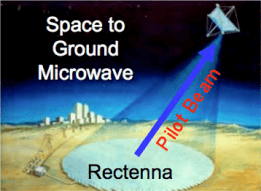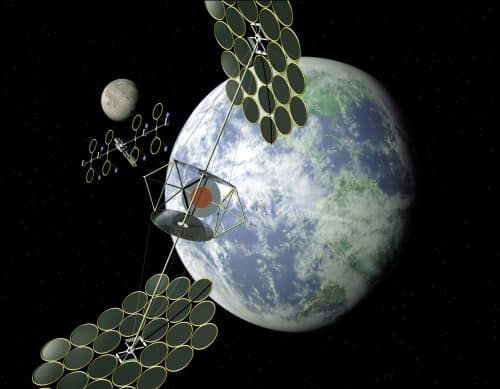The Chinese plan to build a solar power plant in a place where the night and the clouds will not interfere with energy production: in space
Racheli Vox, Angle - Science and Environment News Agency
In recent weeks, the eyes of the Israelis have been fixed on the Berashit spaceship, and the national breath stops for a moment with every maneuver it performs on its long journey to the moon. If and when the spacecraft's mission is successful, it will make Israel the fourth country in the world to reach the moon. It was preceded by the United States, Russia and China, which only recently became the first country in the world to land a probe on the far side of the moon. The Chinese space program does not stop there, and today its scientists are working on a new ambitious plan: the construction of the first solar power plant in space, which will produce renewable energy from the sun and supply it to the earth. Thus, the process can be carried out without many of the difficulties that exist in it on the surface of the earth.
36 thousand kilometers above the ground
According to the Chinese Ministry of Science and Technology, the planned power plant will generate electricity in space from the sun's energy, and then convert it into microwave or laser radiation, which will be projected to a station that will be placed on the surface of the earth. Or then, the receiving station will convert the radiation back into electricity, which will be routed to the power grid.
The space power plant is expected to hover at an altitude of 36 thousand kilometers above the surface of the earth. Objects launched to this height naturally circle the earth at the same speed as it rotates around itself, therefore to a person observing from the ground they appear stationary in the sky. Today, satellites are launched into this orbit that are intended to be permanently above the same place on Earth (called geostationary satellites), such as communication satellites that serve a certain area on Earth. In this way, the space power plant will be able to hover permanently above the ground station to which the energy will be projected.

On paper, producing solar energy in space has several advantages over producing it on Earth. First, the Earth's atmosphere scatters, absorbs and reflects a significant part of the solar radiation that passes through it, so that performing the process in space, before the passage of the radiation in the atmosphere, will allow the solar power generation systems to be exposed to a greater flow of solar energy per unit area than on the surface of the Earth. In addition, sunlight does not reach the solar power plants located on the surface of the planet at night when clouds block it, a problem that will not affect a station located outside the borders of the planet.
According to the Chinese Ministry of Science and Technology, the planned power plant will generate electricity in space from the sun's energy, and then convert it into microwave or laser radiation, which will be projected to a station that will be placed on the surface of the Earth. Photo: SpaceX – unsplash
According to the Chinese report, the space power plant will be able to operate for 99 percent of the time - six times what is possible on Earth. Beyond being used as a source of clean electricity for the planet, the Chinese plan to use the electricity produced at the station as a source of energy for future missions to explore the depths of space.
Today, the Chinese are working on establishing an experimental base in the city of Chongqing in the west of the country, where the project will be developed. By 2025, the scientists plan to send a small experimental station into the stratosphere, the layer of the atmosphere that ends at a height of 50 kilometers above the earth's surface. According to the plan, in 2030 a power plant of one megawatt will be launched outside the atmosphere (for comparison, the production capacity of the largest power plant in Israel, the "Orot Rabin" plant in Hadera, is 2,590 megawatts), and by 2050 it is planned to start operating of the full spacecraft power plant, the output of which will be 1,000 megawatts.
A thousand tons in space
It is understood that such a project is very complex to carry out. According to the Chinese report, the space power plant is expected to weigh no less than 1,000 tons. For comparison, the weight of the International Space Station currently stands at about 400 tons. It is very difficult to launch such a heavy object into space at once, so the possibility of the station being built in space, using robots and XNUMXD printing, is being considered.
Beyond building the station itself, transferring such significant amounts of microwave or laser radiation from space over time is not a simple process, and the scientists will have to make sure that they do not cause health and ecological damage to humans and the animals and plants on Earth. Prof. Yoav Yair, Dean of the School of Sustainability at the Interdisciplinary Center in Herzliya and atmosphere and space researcher, is optimistic about this difficulty. "I don't think it's an insurmountable technological barrier, the concept is physically possible," he says.
Although the days of the space race between the United States and the Soviet Union are over, even today China's ambition to "conquer" space is part of the country's effort to establish itself as a power of technological, economic and military superiority. In the meantime, China has accumulated several significant successes in the field, which include several manned missions sent into space, a probe that landed on the hidden side of the moon and another that landed on its visible side, as well as many satellites. Their plans for the future include, among other things, sending a manned spacecraft to the moon in the coming years.

The Chinese are not the only ones investigating the field of solar energy production in space. Last year, researchers at the California Institute of Technology reported that they had created a prototype of a space solar power plant: a device made of lightweight tiles, capable of extracting energy from the sun, converting it to radio waves and transmitting it through antennas. Japan has also explored the idea of launching a solar power plant into space.
Last year, researchers at the California Institute of Technology reported that they had created a prototype of a space solar power plant: a device made of lightweight tiles, capable of extracting energy from the sun, converting it to radio waves and transmitting it through antennas. Photo: NASA - unsplash
The sun never ends
Currently, the day when the electricity in our house will come from a space solar power plant is still far away, and it will be preceded by years of technology development, experiments, mistakes and of course the investment of a lot of money. However, as the Chinese proverb says - even a journey of a thousand miles begins with one small step. "At the moment there are no such practical capabilities, but as a practical plan it is feasible", says Yair. "The Chinese set distant and big goals for themselves and I believe they intend to reach them. It's an ambitious but possible project and I hope it succeeds."
Yair emphasizes that the transition to a more significant use of solar energy, whether it is produced in space or here on Earth, is necessary. "The sun's energy is endless and we will be able to use it for at least another few billion years, while the oil, coal and gas will wear out and disappear," he says. Solar energy is considered clean energy, in contrast to fossil fuels, the use of which leads to the release of polluting greenhouse gases (mainly carbon dioxide) that cause climate change. Today, only 1.5 percent of the demand for electricity in the US and worldwide is provided by solar energy. The national goal of the State of Israel is to produce 17 percent of the country's electricity from renewable energies by 2030, but there is still a long way to go.
So until the first space solar power plant is launched outside the atmosphere, it is definitely worth investing in increasing the use of solar energy here, under the sky.

6 תגובות
Gentlemen of the knowledge.
I understand there is a secret twist in this story, and I intend to reveal it now.
Well, what are things supposed to be?
It is quite clear that, even if an efficient space technology is developed to convert solar radiation into laser (or microwave) radiation, then the energy supply that can be transferred to the Earth's surface will be small and negligible in terms of the energy consumption of humanity, or even of a single country, or even of a city
The energy supply limit stems from the size limit of the surface for absorbing solar energy in space.
Installing and maintaining a surface with a large surface area, capable of absorbing a lot of solar radiation, is a hopeless technological task.
Therefore, in my opinion, the Chinese project is intended, not for the supply of energy to DHA, but for its supply to:
(*)-in the first step—to the planned Chinese space station. (*) - and in the second and third stages - to the colonies that the Chinese are planning to establish on the moon and then on Mars, as well as to the spacecraft that will sail to Mars on a journey that will take over a year.
you have to pay atention:
Supplying constant and reliable energy to the space station, to the spacecrafts that will sail to Mars, and to the future colonies on the moon and on Mars, using the future technology, will allow the creation around those sites, magnetic fields that will protect the people and the rest of the life that will be inside them, from the cosmic radiation. Similar to the protection that provides us. The magnetic field of KDA.
It seems that this is the only way the human journey to Mars will be possible.
Nothing to say;
China is challenging the USA, Russia and Europe in a very impressive way.
I want to strengthen the fourth response a little...
Regardless of how the energy will be projected to the station on Earth, it is clear that some of it will be lost on the way, in the atmosphere and turn into heat.
Even if this energy loss is a single percent, its effect will be a lot of heating.
Has the effect of this heating on the earth been tested?
Secondly, how will they make sure that aircraft do not cross this energy line? Any aircraft will be severely damaged in such an event. A bird, regardless of its size, will probably have nothing left...
How will the microwave radiation affect the atmosphere, part of the radiation will go to heat the earth
So the end result was a loss
What is the percentage of energy loss between the origin station and the delivery station on the ground?
Can a calibration transfer be with one or multiple laser beams?
Can the Chinese also turn the powerful laser beam into a military weapon?
I believe that what will solve the global energy problem will be nuclear fusion reactors, such as ITER and Wendelstein, and not solar stations in space that weigh 2.5 times as much as the ISS. In any case, I would love to see both of them in action.
If the spacecraft power station is geostationary, it seems to me that it also experiences night, every day.